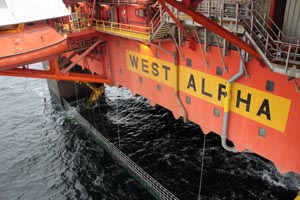Rosneft and ExxonMobil Start Drilling in the Kara Sea

Rosneft and ExxonMobil joint venture company Karmorneftegaz began drilling of Universitetskaya-1, the Russian Federation's northernmost well using the West Alpha rig.
The start of the drilling was launched by Russian President Vladimir Putin during a teleconference with head of Rosneft Igor Sechin and head of ExxonMobil Russia Glenn Waller who were both present in the Kara Sea. Special representative of President of the Russian Federation on international cooperation in the Arctic and Antarctic, member of the Board of Directors of Rosneft Artur Chilingarov and North Atlantic Drilling representative Jan Tore Theimann also took part in the ceremony.
“The start of exploratory drilling in the Kara Sea is the most important event of the year for the global oil and gas industry. As a result of this work we are planning to discover a new Kara sea oil province. Developing of the Arctic shelf has a huge multiplicative effect on the whole Russian economy” – said Igor Sechin.
The West Alpha rig was provided by the Norwegian company North Atlantic Drilling which signed long-term agreements with Rosneft on 30 July 2014 for the offshore drilling. West Alpha was transported via the Barents, Pechora and Kara Seas and installed on the drilling site of the East Prinovozemelskiy-1 Licence Area in the Kara Sea. The drilling rig made the way of over 1900 nautical miles to reach its destination. The rig is 30,700 tons in deadweight, 70 m long, 66 m wide, the derrick hangs 108.5 meters over the main deck, and it drafts during drilling for 21.5 m.
The rig is held on the drilling site by an 8-anchor positioning system, which provides advanced stability for the rig. Most of the platform is outside the reach of waves, which are no impediment for the rig's operation. The maximum drilling depth of West Alpha is 7 km. The drilling will continue for two months.
Rosneft and ExxonMobil experts spent several months preparing the rig for the Kara Sea drilling operation. West Alpha was upgraded to improve the overall reliability of its main and supplementary equipment and for all systems to be ready for low temperatures, including, most importantly, life support and evacuation systems.
The rig is equipped with an innovative system for the monitoring of ice condition, icebergs detection and tracking of sea ice. It uses infrared cameras and modern onboard radars, and analyzes satellite and air intelligence data.
To make sure West Alpha can operate safely in severe ice conditions, Rosneft and ExxonMobil developed a unique iceberg collision prevention plan. It even includes applying physical action to the ice. Should experts suspect a hummock or floe can damage the rig, special support vessels will tow it away to a safe distance. If physical action is impossible, the system will isolate the well in a way that is harmless for the environment, and the rig will transfer to a safer location. The rig is equipped with two groups of blowout preventers and an enhanced subsea shut-in device.

